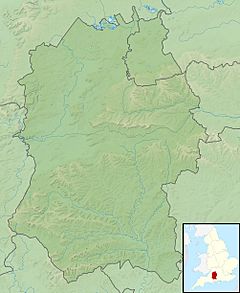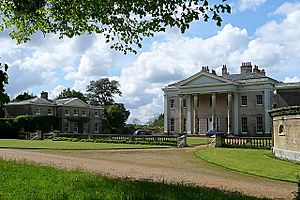River Avon, Hampshire facts for kids
Quick facts for kids River Avon |
|
|---|---|
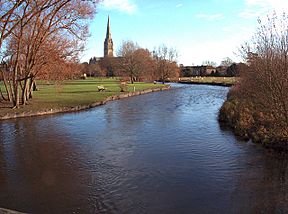
The River Avon in Salisbury
|
|
|
Source of the west headwater of this Avon
|
|
| Country | United Kingdom |
| Country within the UK | England |
| Counties | Wiltshire, Hampshire, Dorset |
| Physical characteristics | |
| Main source | Vale of Pewsey, Wiltshire 124 metres (407 ft) 51°20′56″N 1°56′53″W / 51.349°N 1.948°W |
| River mouth | English Channel Christchurch, Dorset 51°20′56″N 1°56′53″W / 51.349°N 1.948°W |
| Length | 96 km (60 mi) |
| Basin features | |
| Tributaries | |
| Designation | |
| Official name: Avon Valley | |
| Designated: | 2 February 1998 |
| Reference #: | 926 |
The River Avon is a river in the south of England. It starts in Wiltshire and flows through the city of Salisbury. Then it goes through western Hampshire. Finally, it reaches the English Channel through Christchurch Harbour in Dorset.
People sometimes call it the Salisbury Avon or the Hampshire Avon. This helps tell it apart from other rivers with the same name in Britain. The Avon is special because it has more types of fish than any other river in Britain. You can also see a rare natural event called anchor ice here. The river valley is full of old farms and fields. Many large, historic houses with big parks are found along its banks. There are also many ancient sites, like Stonehenge, Avebury and Associated Sites, which is a World Heritage Site. Other important places include Old Sarum and the "Thornham Down prehistoric and medieval landscape."
Contents
- What's in a Name? The River Avon's Meaning
- Where the River Avon Flows: Its Journey
- Avon Valley Path: Following the River
- Old Laws and River Access for Canoes
- Grand Houses and Parks Along the Avon Valley
- Ancient Landscapes: Scheduled Monuments
- Towns and Villages Along the River Avon
- Special Protections: River Designations
- Working to Protect the River: Conservation Efforts
- Images for kids
- See also
What's in a Name? The River Avon's Meaning
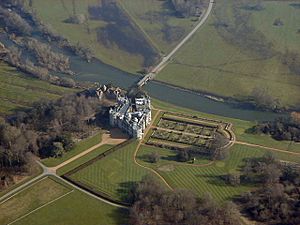
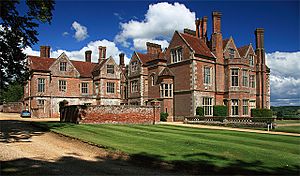
The name of the river, Avon, actually means "river" in an old language called Proto-Brythonic. So, "River Avon" technically means "River River"! This is called a tautology.
Where the River Avon Flows: Its Journey
The River Avon starts as two separate streams. The western stream begins east of Devizes. It collects water from the Vale of Pewsey. This stream is joined by Etchilhampton Water.
The eastern stream starts at Easton Royal, east of Pewsey. It is joined by the Woodborough Stream.
Merging Streams and Southern Flow
The two streams meet at Upavon. From there, the river flows south across Salisbury Plain. It passes through towns like Durrington, Amesbury, and Salisbury.
South of Salisbury, the river enters the Hampshire Basin. It flows along the western edge of the New Forest. It goes through Fordingbridge and Ringwood.
Meeting the Sea
The River Avon then meets the River Stour at Christchurch. Together, they flow into Christchurch Harbour. The harbour then opens into the English Channel.
Tributaries and Water Divides
Many important smaller rivers, called tributaries, join the Avon. These include the Nadder, Wylye, Bourne, and Ebble. They all meet the Avon near Salisbury.
North of the river's western source is Morgan's Hill. This spot is special because rainfall here can flow in three different directions. It can go to the English Channel (via this River Avon), the Atlantic Ocean (via the Bristol Avon), or the North Sea (via the Kennet and Thames).
About half of the river is in Wiltshire. The rest is in Hampshire and Dorset.
Avon Valley Path: Following the River
The Avon Valley Path is a walking trail. It follows the River Avon between Salisbury and Christchurch. It's a great way to explore the river's journey.
Old Laws and River Access for Canoes
In 1664, a law was passed to make the River Avon navigable. This meant boats like canoes could travel from Christchurch up to Salisbury. However, the work needed to make the river navigable was never fully finished.
Because of this, whether people have the right to use canoes all the way to Salisbury is still debated. Court cases in the 1700s tried to settle this, but the issue remains unclear.
Grand Houses and Parks Along the Avon Valley
The Avon valley is home to many large, historic houses. These houses have big parks and gardens. They were often built by wealthy landowners. Their money came from the rich farmland in the valley.
Some of these famous houses include:
- Conock Manor, Chirton
- Amesbury Abbey (with special gardens, a cave, and a replica Chinese temple)
- Lake House, Wilsford
- Heale House, Middle Woodford
- Wilton House (known for its beautiful architecture and gardens)
- Longford Castle (with two bridges over the river and statues)
- Trafalgar Park, Downton (includes a chapel)
- Hale Park (with a lodge, barns, and granaries)
- Breamore House (includes a tower and a museum cottage)
- Avon Tyrrell House, Sopley (with a lodge and a gazebo)
Ancient Landscapes: Scheduled Monuments
The biggest and most famous ancient site along the river is the World Heritage Site that includes Stonehenge. This area has massive earthworks and ancient structures.
Other important ancient sites include large earthworks at Old Sarum. There is also the Thornham Down area, which shows signs of prehistoric and medieval life.
Towns and Villages Along the River Avon
The River Avon flows through many towns and villages.
Wiltshire Settlements
- Upper Avon Valley:
- Upavon
- East and West Chisenbury
- Enford
- Coombe
- Fittleton
- Haxton
- Netheravon
- Figheldean
- Milston
- Durrington
- Bulford
- Amesbury
- Woodford Valley:
- West Amesbury
- Wilsford cum Lake
- Great Durnford
- The Woodfords
- Little Durnford
- Salisbury Area:
- Stratford-sub-Castle
- Salisbury
- Wiltshire Watermeadows:
- Britford
- Bodenham
- Charlton All Saints
- Downton
Hampshire Settlements
- Breamore
- Burgate
- Fordingbridge
- Bickton
- Ibsley
- Ringwood
- Sopley
Dorset Settlements
- St Ives
- Burton
- Fairmile
- Christchurch
Special Protections: River Designations
Parts of the River Avon and its valley have special protections. This helps keep the natural environment safe.
In 1993, the Avon valley in Hampshire was named a Site of Special Scientific Interest (SSSI). This means it's an important area for wildlife and geology.
In 1996, almost the entire river, from Patney to Christchurch, became part of the River Avon System SSSI. This also includes its tributaries like the Wylye, Nadder, Bourne, and Dockens Water.
Working to Protect the River: Conservation Efforts
Several projects have worked to protect the River Avon.
STREAM Project
The STREAM project started in 2005 and lasted four years. This project aimed to improve the homes (habitats) for many species. These included plants like water-crowfoot and fish like Atlantic salmon, brook lamprey, sea lamprey, and bullhead. It also helped snails like Desmoulin's whorl snail and birds like gadwall and Berwick's swan.
Living River Project
A related project, called Living River, ran from 2006 to 2010. Its goal was to make the river more accessible for people to enjoy. It also aimed to help the variety of life (biodiversity) in and around the river.
Both STREAM and Living River were recognized for their great work. They were shortlisted for the Thiess International Riverprize in 2009.
Images for kids
See also
 In Spanish: Río Avon (Hampshire) para niños
In Spanish: Río Avon (Hampshire) para niños


